RCF LIVEPAD-24CX-USB, LIVEPAD-16CX-USB Users Manual
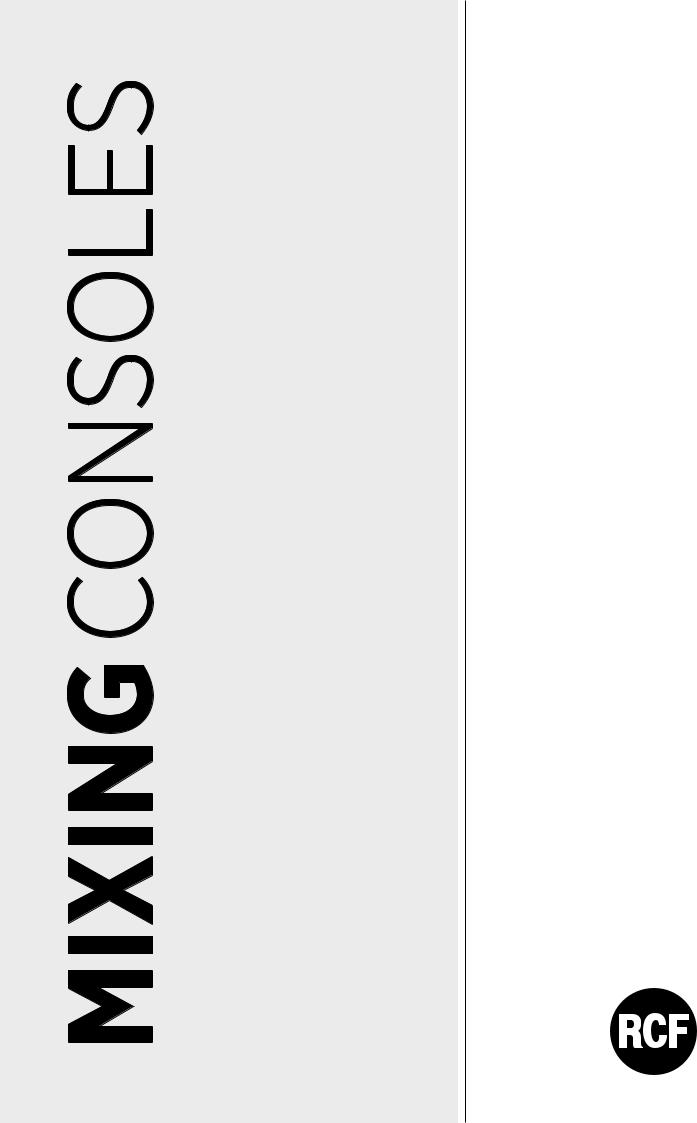
L-PAD
16CXusb
24CXusb
OWNER MANUAL
MANUALE UTENTE MANUEL UTILISATEUR MANUAL DEL USUARIO BEDIENUNGS-ANLEITUNG
HIGH PERFORMANCE VERSATILE COMPACT LIVE MIXERS
MIXER LIVE AD ALTE PRESTAZIONI COMPATTO E VERSATILE
MÉLANGEURS LIVE HAUTE PERFORMANCE COMPACTS ET POLYVALENTS
MESAS DE MEZCLAS PARA DIRECTO DE ALTO RENDIMIENTO, COMPACTAS Y VERSÁTILES
DER VIELSEITIGE UND KOMPAKTE HIGH PERFORMANCE LIVE-MIXER

LANGUAGE
ENGLISH |
4 |
ITALIANO |
14 |
FRANÇAIS |
24 |
ESPAÑOL |
34 |
DEUTSCH |
44 |
CONFIGURATION EXAMPLE / ESEMPIO DI CONFIGURAZIONE / EXEMPLE DE |
54 |
CONFIGURATION / EJEMPLO DE CONFIGURACIÓN / KONFIGURATIONSBEISPIEL |
|
SPECIFICATIONS / SPECIFICHE / SPÉCIFICATIONS / ESPECIFICACIONES |
58 |
/ TECHNISCHE DATEN |
|
PHYSICAL SPECIFICATIONS / SPECIFICHE FISICHE / SPÉCIFICATIONS PHYSIQUES |
59 |
/ ESPECIFICACIONES FÍSICAS / PHYSIKALISCHE DATEN |
|
2
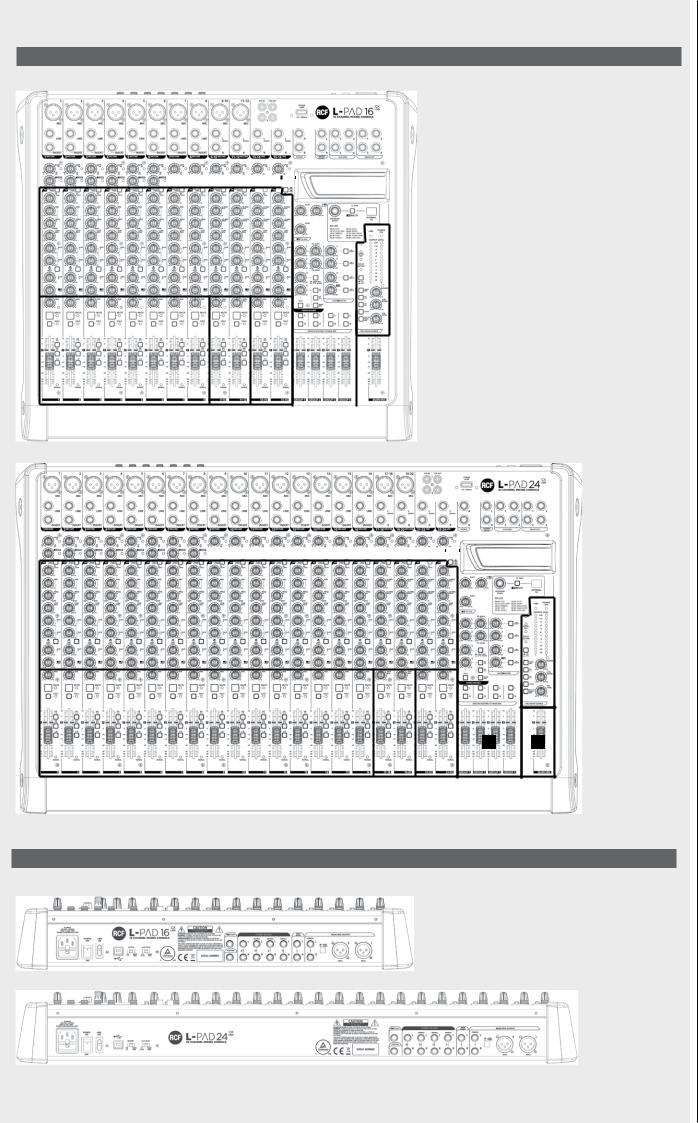
FRONT PANEL / PANNELLO FRONTALE / PANNEAUAVANT / PANEL DELANTERO / GERÄTEVORDERSEITE
|
|
|
|
|
|
|
|
|
|
|
|
|
|
|
|
|
|
|
|
|
|
|
|
|
|
|
|
|
|
|
|
|
|
|
|
|
|
|
|
|
|
|
|
|
|
|
|
|
21 |
|
|
|
22 |
|
|
|
|
|
|
|
|
|
|
|
|
|
|||
|
|
|
|
|
|
|
|
|
|
|
|
|
|
|
|
|
|
|
|
|
|
|
|
|
|
|
|
|
|
|
|
|
|
|
|
|
|
|
|
|
|
|
|
|
|
|
|
|
|
|
|
|
|
|
|
|
|
|
|
|
|
|
|
|
|
|
|
|
|
|
|
|
|
|
|
|
|
2 |
|
|
3 |
|
|
|
|
|
|
|
|
|
|
|
|
|
|
|
|
|
|
|
|
|
|
|
|
1 |
|
|
|
|
|
|
|
|
|
|
|
|
|
|
|
|
|
|
|
|
|
|
20 |
|
|
|
|
|
|
||||
|
|
|
|
|
|
|
|
|
|
|
|
|
|
4 |
|
|
|
|
|
|
|
|
|
|
|
|
|
|
||||||
|
|
|
|
|
|
|
|
|
|
|
|
|
|
|
|
|
|
|
|
|
|
|
|
|
|
|
|
|
|
|
|
|
|
|
|
|
|
|
|
|
|
|
|
|
|
|
|
|
|
|
|
|
|
|
|
|
|
|
|
|
|
|
|
|
|
|
|
|
|
|
|
|
|
|
|
|
|
|
|
|
|
|
|
|
|
|
|
|
|
|
|
|
|
|
|
|
|
|
|
|
|
|
|
|
|
|
|
|
|
|
|
|
|
|
|
|
|
|
|
|
|
5 |
|
|
|
|
|
|
23 |
|
|
|
|
|
|||||
|
|
|
|
|
|
|
|
|
|
|
|
|
|
|
|
|
|
|
|
|
|
|
|
|
|
|
|
|
|
|
|
|
|
|
|
|
|
6 |
|
|
|
|
|
|
|
7 |
|
|
8 |
|
|
|
|
|
|
|
|
|
|
|
|
|
|
|
|
|
|
|
|
|
|
|
|
|
|
|
|
|
|
|
|
19 |
|
|
|
|
|
18 |
|
|
|
|
||||||||||||
|
|
|
|
|
|
|
|
|
|
|
|
|
|
|
|
|
|
|
|
|
|
|
|
|
|
|
|
|||||||
|
|
|
|
|
|
|
|
|
|
|
|
|
|
|
|
|
|
|
|
|
|
|
|
|
|
|
|
|
|
|
|
|
|
|
|
|
|
|
|
|
|
|
|
|
|
|
|
|
|
|
|
|
|
|
|
|
|
|
|
|
|
|
|
|
|
||||
|
|
|
9 |
|
|
|
|
|
|
|
|
|
|
|
|
|
|
|
|
|
|
|
|
|
|
|
|
|
|
|
|
|||
|
|
|
|
|
|
|
|
|
|
|
|
|
|
|
|
|
|
16 |
|
|
|
15 |
|
|
|
17 |
|
|
||||||
|
|
|
|
|
|
|
|
|
|
|
|
|
|
|
|
|
|
|
|
|
|
|
|
|
|
|||||||||
|
|
|
|
|
|
|
|
|
|
|
|
|
|
|
|
|
|
|
|
|
|
|
|
|
|
|
|
|
|
|
|
|
|
|
|
|
|
|
|
|
|
|
|
|
|
|
10 |
|
11 |
|
12 |
|
|
|
|
|
|
|
|
|
|
|
|
|
|
|
|
|
|
|
|
|
|
|
|
|
|
13 |
|
|
14 |
|
|
|
|
|
|
|
|
|
|
|
|
|
L-PAD 16CX USB
|
|
|
|
|
|
|
|
|
|
|
|
|
|
|
|
|
|
|
|
|
|
|
|
|
|
|
|
|
|
|
|
|
|
|
|
|
|
|
|
|
|
|
|
|
|
|
|
|
|
21 |
|
|
|
22 |
|
|
|
|
|
|
|
|
|
|
|
|
|
||||
|
|
|
|
|
|
|
|
|
|
|
|
|
|
|
|
|
|
|
|
|
|
|
|
|
|
|
|
|
|
|
|
|
|
|
|
|
|
|
|
|
|
|
|
|
|
|
|
|
|
|
|
|
|
|
|
|
|
|
|
|
|
|
|
|
|
|
|
|
|
|
|
|
|
|
|
|
|
|
|
2 |
|
|
3 |
|
|
|
|
|
|
|
|
|
|
|
|
|
|
|
|
|
|
|
|
|
|
|
|
|
1 |
|
|
|
|
|
|
|
|
|
|
|
|
|
|
|
|
|
|
|
|
|
|
|
20 |
|
|
|
|
|
|
||||
|
|
|
|
|
|
|
|
|
|
|
|
|
|
|
4 |
|
|
|
|
|
|
|
|
|
|
|
|
|
|
||||||
|
|
|
|
|
|
|
|
|
|
|
|
|
|
|
|
|
|
|
|
|
|
|
|
|
|
|
|
|
|
|
|
|
|
|
|
|
|
|
|
|
|
|
|
|
|
|
|
|
|
|
|
|
|
|
|
|
|
|
|
|
|
|
|
|
|
|
|
|
|
|
|
|
|
|
|
|
|
|
|
|
|
|
|
|
|
|
|
|
|
|
|
|
|
|
|
|
|
|
|
|
|
|
|
|
|
|
|
|
|
|
|
|
|
|
|
|
|
|
|
|
|
|
|
|
|
5 |
|
|
|
|
|
|
23 |
|
|
|
|
|
|||||
|
|
|
|
|
|
|
|
|
|
|
|
|
|
|
|
|
|
|
|
|
|
|
|
|
|
|
|
|
|
|
|
|
|
|
|
|
|
|
6 |
|
|
|
|
|
|
7 |
|
|
8 |
|
|
|
|
|
|
|
|
|
|
|
|
|
|
|
|
|
|
|
|||
|
|
|
|
|
|
|
|
|
|
19 |
|
|
|
|
|
18 |
|
|
|
|
|||||||||||||||
|
|
|
|
|
|
|
|
|
|
|
|
|
|
|
|
|
|
|
|
|
|
|
|
|
|
|
|
|
|||||||
|
|
|
|
|
|
|
|
|
|
|
|
|
|
|
|
|
|
|
|
|
|
|
|
|
|
|
|
|
|
|
|
|
|
|
|
|
|
|
|
|
|
|
|
|
|
|
|
|
|
|
|
|
|
|
|
|
|
|
|
|
|
|
|
|
|
|
|
||||
|
|
|
9 |
|
|
|
|
|
|
|
|
|
|
|
|
|
|
|
|
|
|
|
|
|
|
|
|
|
|
|
|
|
|||
|
|
|
|
|
|
|
|
|
|
|
|
|
|
|
|
|
|
|
|
16 |
|
|
|
15 |
|
|
|
17 |
|
|
|||||
|
|
|
|
|
|
|
|
|
|
|
|
|
|
|
|
|
|
|
|
|
|
|
|
|
|
|
|||||||||
|
|
|
|
|
|
|
|
|
|
|
|
|
|
|
|
|
|
|
|
|
|
|
|
|
|
|
|
|
|
|
|
|
|
|
|
10 |
|
11 |
|
12 |
13 14
L-PAD 24CX USB
REAR PANEL / PANNELLO POSTERIORE / PANNEAU ARRIÈRE / PANEL TRASERO / GERÄTERÜCKSEITE
|
|
|
|
|
|
|
|
|
|
27 |
|
|
|
|
|
|
|
|
|
|
|
|
|
|
|
|
|
|
|
|
|
|
|
|
|
|
|
|
|
|
|
|
|
|
|
|
|
|
|
|
|
|
|
|
|||||||
|
|
|
|
|
|
|
|
|
|
28 |
|
|
|
|
|
|
|
|
|
|
|
|
|
L-PAD 16CX USB |
|
|||||
|
32 |
|
31 |
30 |
|
29 |
|
|
|
|
|
|
26 |
|
25 |
|
24 |
|
|
|
|
|
|
|||||||
|
|
|
|
|
|
|
|
|
|
|
|
|
|
|
|
|
|
|
|
|
||||||||||
|
|
|
|
|
|
|
|
|
|
|
|
|
|
|
|
|
|
|
|
|
|
|
|
|
|
|
|
|
|
|
|
|
|
|
|
|
|
|
|
|
|
|
|
|
|
|
|
|
|
|
27 |
|
|
|
|
|
|
|
|
|
|
|
|
|
|
|
|
|
|
|
|
|
|
|
|
|
|
|
|
|
|
28 |
|
|
|
|
|
|
|
|
|
L-PAD 24CX USB |
|
32 |
|
31 |
30 |
|
29 |
|
|
|
|
|
|
|
|
|
|
|
|
|
|
|
|
26 |
|
25 |
|
24 |
|
||
|
|
|
|
|
|
|
|
|
|
|
|
|
|
|
|
|
|
|
|
|
||||||||||
3
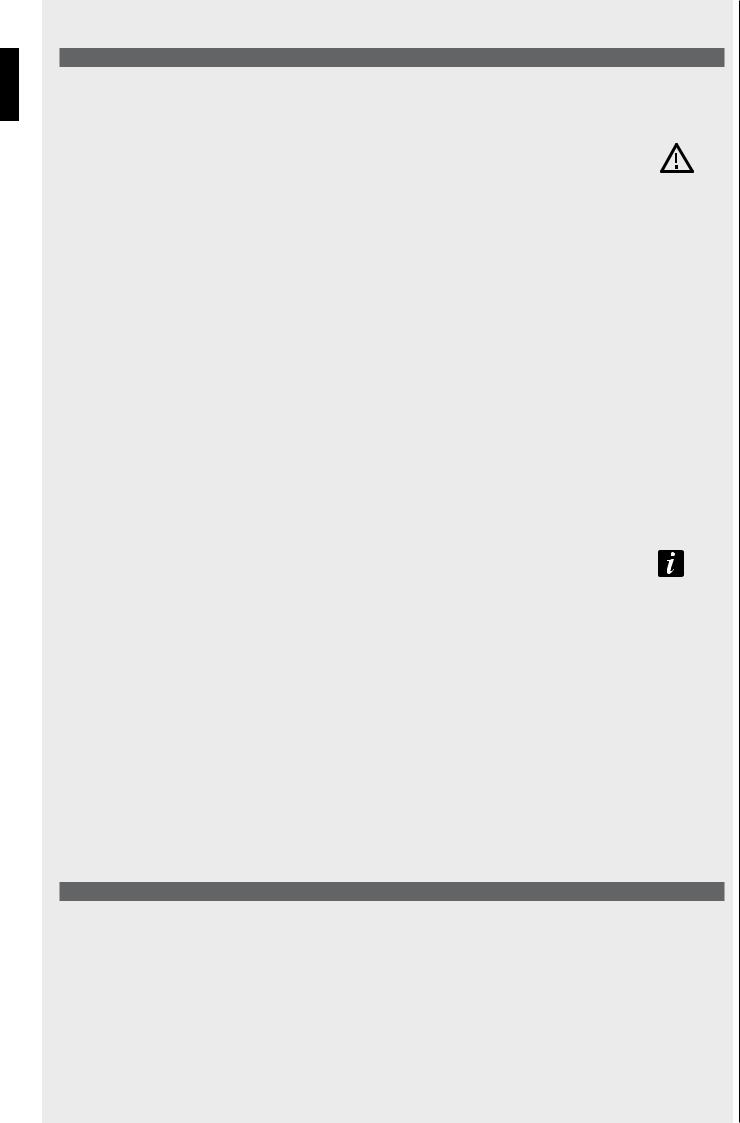
ENGLISH
SAFETY PRECAUTIONS
Before connecting and using this product, read the instructions provided in this manual carefully and keep it for future reference. This manual is an integral part of the product and it must accompany it even in the case of changes of ownership, so that the new owner is aware of the method of installation and use and all safety warnings. Incorrect installation and use of the product shall relieve RCF S.p.A. of any and all liability.
CAUTION: to prevent the risk of flames or electric shock, do not ever expose this product to the rain or humidity. |
|
1. All warnings, in particular those relating to safety, must be read with special attention, as they contain important information. |
|
2. MAIN SUPPLY FROM THE MAINS |
WARNINGS |
a.The supply voltage of the device is sufficiently high to constitute a risk of electric shock to persons: never install or connect the device with the power supply cable plugged into the mains.
b.Before powering this product, make sure that all connections are correct and that the voltage of your mains supply matches the value on the device data plate; if this is not the case, please contact an RCF dealer.
c.The metal parts of the device are earthed via the power supply cable.
d.A device with CLASS I construction must be connected to the mains socket with a protective earthing connection.
e.Make sure that the power supply cable of the device cannot be stepped on or crushed by objects, to make sure it remains intact and in perfect working order.
f.To avoid the risk of electric shock, never open the device: there are no parts that can be used by the user inside.
3.Do not allow objects or liquids to penetrate the product, as this may cause a short circuit. The device must not be exposed to dripping or splashing water; no naked flame sources (e.g. lighted candles) and no objects filled with liquid (e.g. vases) must be placed on top of the device.
4.Do not perform any work / modifications / repairs except for those expressly described in this manual. Contact an authorised service centre or highly qualified personnel when:
- the device is not working (or is working abnormally); - the power supply cable has been seriously damaged; - objects or liquids have penetrated the device;
- the device has undergone major knocks.
5.If this product is not used for long periods of time, unplug the power supply cable from the mains.
6.If the product releases abnormal odours or smoke, turn off the power immediately and unplug the power supply cable.
7.Do not connect this product to other devices and accessories not envisaged. Do not try to hang this product using elements that are not designed or suitable for this purpose. To avoid the risk of falling, do not stack multiple units of this product, unless this option is expressly specified in the instruction manual.
8.RCF S.p.A. strongly recommends that the installation of this product be carried out only by professional qualified installers (or specialised installation companies) able to do it properly and to certify installation in accordance with the applicable regulations in force. The entire audio system must comply with the applicable rules and regulations regarding electrical systems.
9.Stands and Carts
Where envisaged, the product should only be used on carts or stands recommended by the manufacturer. The device-stand / devicecart assembly should be moved with the utmost care. Sudden stops, excessive pushing force and uneven or tilted floors could cause the assembly to overturn.
10. Hearing loss
Exposure to high sound levels can cause permanent hearing loss. The sound pressure level dangerous to one‘s hearing varies greatly from one person to another and depends on the duration of exposure. To avoid potentially dangerous exposure to high sound pressure levels, anyone who is exposed to these levels must use adequate protection; when a transducer capable of producing high sound levels is in use, ear plugs or protective headsets must be worn. See the technical instruction data to find out the maximum sound pressure levels that the speakers are capable of producing.
11.Place the product away from heat sources and ensure adequate air circulation all around.
12.Do not overload this product for extended periods of time.
13.Never force the controls (buttons, knobs, etc.).
14.Do not use solvents, alcohol, petrol or other volatile substances to clean the external parts of the unit; use a dry cloth.
15.Do not point microphones near and in front of the speakers, so as to avoid any feedback („Larsen effect“).
NOTE ON CABLES FOR AUDIO SIGNALS
To prevent the occurrence of noise on the cables that carry signals from the microphones or on the line (for example, 0dB), use only screened cables and avoid laying them in the vicinity of:
-equipment that produces strong electromagnetic fields;
-cables from the power mains;
-speaker lines.
RCF S.p.A. thank you for buying this product, which was made in order to ensure reliability and high performance.
4
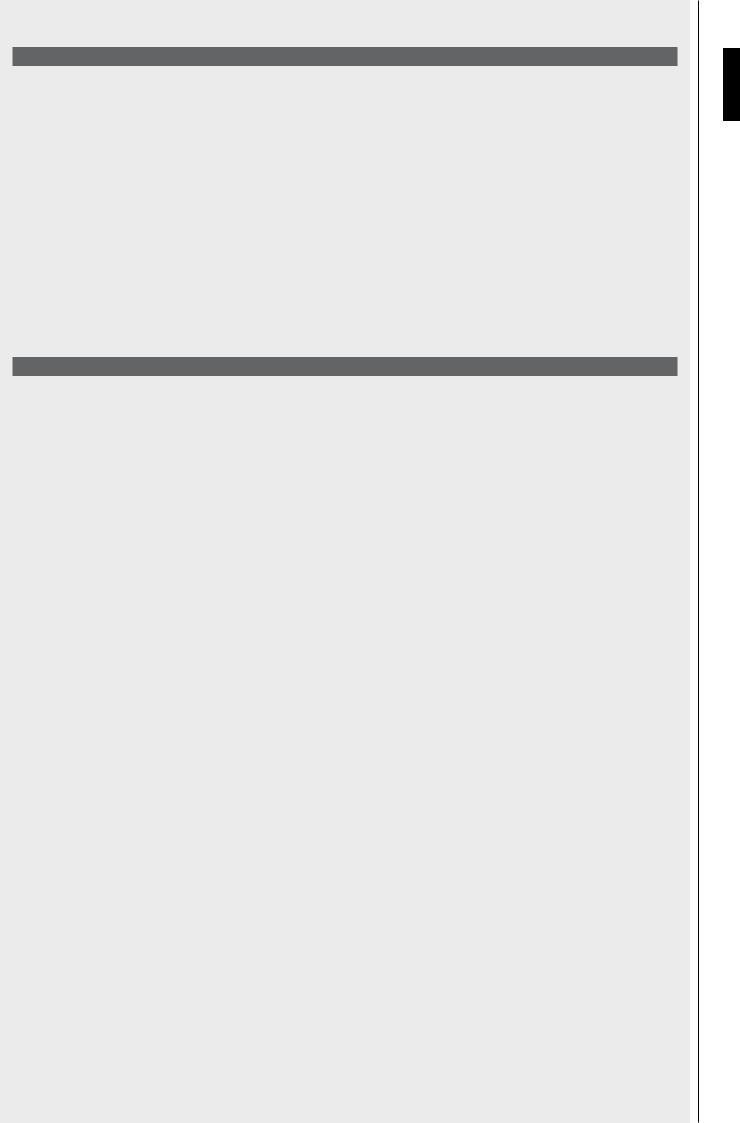
INFORMATION ON THE DEVICE
Thank you for purchasing a RCF mixing console.
L-PAD16CXusb and L-PAD24CXusb are versatile audio mixers equipped with all the tools needed for appropriately processing multiple audio signals from a variety of sources. The features can be expanded by adding optional cards to implement MP3 audio player/recorder or Bluetooth functions.
CLEAR SOUND
RCF mixing consoles devices combine RCF‘s professional “sound culture“ heritage with innovative design and dedicated manufacturing. RCF mixing consoles secure clear sound, accurate sound dynamics and extreme versatility of use by passionate professional users. RCF mixing consoles are designed to combine perfectly with RCF active speakers.
RELIABILITY
All RCF mixing consoles undergo four extensive instrumental quality tests during construction. A listening test is carried out at the end of production followed by a final quality control inspection to locate any appearance defects, such as scratches or dents. The process guarantees outstanding reliability and makes sure that the device you have purchased is of the highest quality.
DESIGN
The unique design of RCF mixing consoles is an expression of typically Italian RCF creativity. RCF mixing consoles combine modern, excellent ergonomic design. In addition to their striking appearance, the original side profile of the mixers makes them easy to grasp securely.
DESCRIPTION AND MAIN CHARACTERISTICS
L-PAD16CXusb and L-PAD24CXusb are versatile analogue audio mixers, equipped with a USB serial port for connection to a computer and all the tools required for proper processing of multiple audio signals from different sources. The two models differ only in the number of available channels; both are expandable by adding optional cards that allow you to implement functions of recording and playback of MP3 or BLUETOOTH audio files. There is an internal digital effects processor that lets you choose among 99 presets.
L-PAD24CXUSB AUDIO INPUTS
-- CHANNELS 1 to 16: MIC microphone inputs (XLR connector) or LINE level signals (¼“ jack), three-band equalizer with semi-parametric mid, INSERT serial connection for external processors (¼“ jack); signal compressor on the first 8 inputs.
-- CHANNELS 17-18 and 19-20: MIC microphone inputs (XLR connector) or for LINE level stereo signals (double ¼“ jack) with four-band equalizer.
-- CHANNELS 21-22 and 23-24: inputs for LINE level stereo signals (double ¼“ jack) with four-band equalizer; channels 23-24 are alternatively assigned to the USB serial port.
L-PAD16CXUSB AUDIO INPUTS
-- CHANNELS 1 to 8: MIC microphone inputs (XLR connector) or LINE level signals (¼“ jack), three-band equalizer with semi-parametric mid, INSERT serial connection for external processors (¼“ jack); signal compressor on the first 6 inputs.
-- CHANNELS 9-10 and 11-12: MIC microphone inputs (XLR connector) or for LINE level stereo signals (double ¼“ jack) with four-band equalizer.
-- CHANNELS 13-14 and 15-16: inputs for LINE level stereo signals (double ¼“ jack) with four-band equalizer; channels 15-16 are alternatively assigned to the USB serial port.
INPUTS AND OUTPUTS COMMON TO BOTH MODELS
-- MAIN MIX main stereo output with XLR connectors (balanced) and ¼“ jack (unbalanced). -- MAIN INSERT link on the main outputs for external processors (¼“ jack).
-- CONTROL ROOM stereo output (double ¼“ jack). -- 4 GROUP OUT group outputs (¼“ jack).
-- 4 AUX SEND auxiliary sends (¼“ jack).
-- 4 STEREO RETURN stereo returns (double ¼“ jack).
-- 2TK IN audio input (double RCA connector) for music source (e.g. CD player, MP3 player, etc..) or recorder. -- 2TK OUT audio output for recorder.
-- FX STEREO OUT effects output with ¼“ stereo jack connector.
-- 1 FOOTSW jack socket (¼“ TS jack) for foot control for the activation or deactivation of effects. -- USB port for connecting audio to and from your computer.
-- 2 PHONES headphone outputs (¼” stereo jack).
Slot for optional cards:
-- L-PAD PLAYER: MP3 player on USB drive, max. capacity 32 GB, code 13360287;
-- L-PAD PLAYER / RECORDER: MP3 player/recorder on USB drive, max. capacity 32 GB, code 13360288;
-- L-PAD BLUETOOTH: „Bluetooth“ connection card that allows you to play your own music playlists from a „smartphone“, „tablet“ or other device with „Bluetooth“ interface, code: 13360289.
ENGLISH
5

ENGLISH
FUNCTIONS
[1] INPUTS OF CHANNELS 1 TO 6 (L-PAD 16CX USB) / 1 TO 8 (L-PAD 24CX USB).
NOTE: see also the manual section entitled „Wiring the connectors.“
MIC: balanced input with XLR (f) connector for microphone, equipped with „Phantom“ power supply (disconnectable) for the use of electret or condenser microphones.
LINE: Balanced „line level“ input for 1/4“ TRS jack (or unbalanced, 1/4“ TS jack).
INSERT: input / output (1/4“ TRS jack ) for the serial connection of an external signal processor (e.g. compressor).
GAIN: gain control (MIC: 0 ÷ –50 dB; LINE: +20 ÷ –30 dB).
COMP: compressor control that acts both on the threshold of intervention as well as on the compression ratio (0: no compression).
[2] INPUTS OF CHANNELS 7 AND 8 (L-PAD 16CX USB) / 9 TO 16 (L-PAD 24CX USB).
NOTE: see also the manual section entitled „Wiring the connectors.“
MIC: balanced input with XLR (f) connector for microphone, equipped with „Phantom“ power supply (disconnectable) for the use of electret or condenser microphones.
LINE: Balanced „line level“ input for 1/4“ TRS jack (or unbalanced, 1/4“ TS jack).
INSERT: input / output (1/4“ TRS jack ) for the serial connection of an external signal processor (e.g. compressor).
GAIN: gain control (MIC: 0 ÷ –50 dB; LINE: +20 ÷ –30 dB).
[3] INPUTS OF CHANNELS 9-10 AND 11-12 (L-PAD 16CX USB) / 17-18 AND 19-20 (L-PAD 24CX USB).
NOTE: see also the manual section entitled „Wiring the connectors.“
MIC: balanced input with XLR (f) connector for microphone, equipped with „Phantom“ power supply (disconnectable) for the use of electret or condenser microphones.
L (mono) / R: balanced „line level“ stereo input (double 1/4“ TRS jack).
L (left): left channel; R (right): right channel.
Use only the L input for „mono“ signals.
GAIN: gain control (MIC: 0 ÷ –50 dB; L / R: +20 ÷ –30 dB).
[4] INPUTS OF CHANNELS 13-14 AND 15-16 (L-PAD 16CX USB) / 21-22 AND 23-24 (L-PAD 24CX USB).
NOTE: see also the manual section entitled „Wiring the connectors.“
L (mono) / R: balanced „line level“ stereo input (double 1/4“ TRS jack).
L (left): left channel; R (right): right channel.
Use only the L input for „mono“ signals.
GAIN: gain control (+20 ÷ –30 dB).
[5] LINE / USB SELECTOR OF CHANNELS 15-16 (L-PAD 16CX USB) / 23-24 (L-PAD 24CX USB).
LINE: channels 15-16 (L-PAD 16CX USB) / 23-24 (L-PAD USB 24CX) are normally assigned to the respective 1/4“ jack inputs.
USB: channels 15-16 (L-PAD 16CX USB) / 23-24 (L-PAD 24CX USB) are assigned to the USB interface (to receive the audio signal from the connected computer).
6
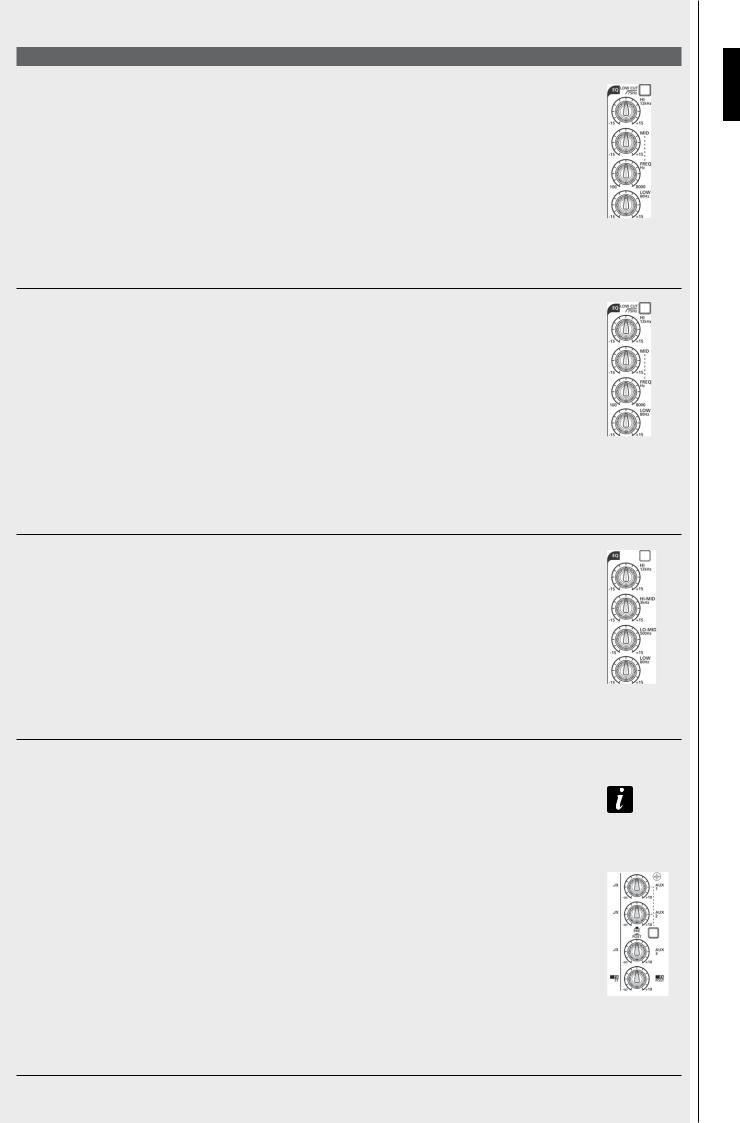
FUNCTIONS
[6] EQUALIZATION OF CHANNELS 1 TO 8 (L-PAD 16CX USB) / 1 TO 16 (L-PAD 24CX USB).
LOW CUT: if pressed, inserts a high-pass filter in the respective channel with cut-off frequency of 75 Hz and 12 dB / octave gradient. We recommend that you only insert it when you use voice microphones (or for instruments with limited low frequency extension), so as to prevent any echoes.
HI: control of the level of high frequencies (12 kHz, –15 ÷ +15 dB).
MID: semi-parametric control of the level of mid frequencies (–15 ÷ +15 dB), where the frequency of operation is selectable (100 ÷ 8000 Hz) via the FREQ control.
LOW: control of the level of low frequencies (80 Hz, –15 ÷ +15 dB).
[7] EQUALIZATION OF CHANNELS 9-10 AND 11-12 (L-PAD 16CX USB) / 17-18 AND 19-20 (L-PAD 24CX USB).
LOW CUT: if pressed, inserts a high-pass filter in the respective channel with cut-off frequency of 75 Hz and 12 dB / octave gradient. We recommend that you only insert it when you use voice microphones (or for instruments with limited low frequency extension), so as to prevent any echoes.
HI: control of the level of high frequencies (12 kHz, –15 ÷ +15 dB).
HI-MID: control of the level of high-mid frequencies (3 kHz, –15 ÷ +15 dB).
LO-MID: control of the level of low-mid frequencies (500 Hz, –15 ÷ +15 dB).
LOW: control of the level of low frequencies (80 Hz, –15 ÷ +15 dB).
[8] EQUALIZATION OF CHANNELS 13-14 AND 15-16 (L-PAD 16CX USB) / 21-22 AND 23-24 (L-PAD 24CX USB).
HI: control of the level of high frequencies (12 kHz, –15 ÷ +15 dB).
HI-MID: control of the level of high-mid frequencies (3 kHz, –15 ÷ +15 dB).
LO-MID: control of the level of low-mid frequencies (500 Hz, –15 ÷ +15 dB).
LOW: control of the level of low frequencies (80 Hz, –15 ÷ +15 dB).
[9] CONTROLS OF AUX AND FX EFFECTS LEVELS FOR EACH CHANNEL.
IMPORTANT NOTE
There are two types of auxiliary send level controls:
PRE-FADER (independent from the control of the channel level), to be used for stage monitors;
POST-FADER (next and so subject to the control of the channel level), used for the connection, for instance, of signal IMPORTANT processors (effects such as reverb, delay, etc.)..
PRE / POST-FADER can be selected for AUX 1 and 2 sends, AUX 3 and FX are only POST-FADER.
The effect control can be used as a fourth auxiliary send (by disabling the internal effect by pressing the FX-MUTE key) for connection to an external signal processor.
AUX 1: control of the AUX 1 auxiliary send level – ∞ ÷ +10 dB.
AUX 2: control of the AUX 2 auxiliary send level – ∞ ÷ +10 dB.
PRE / POST: AUX 1 and 2 are PRE-FADER if this key is released, or POST FADER if pressed.
AUX 3: control of the AUX 3 auxiliary send level – ∞ ÷ +10 dB.
FX: control of the effect level (or fourth auxiliary send; – ∞ ÷ +10 dB).
7
ENGLISH

ENGLISH
FUNCTIONS
[10 - 11 - 12] LEVEL CONTROL AND CHANNEL ASSIGNMENT.
PAN or PAN/BAL or BAL: control to define the position of the respective input signal in the stereo image (L: left channel, R: right channel) or the balance of a stereo signal.
If groups GR 1-2 and/or GR 3-4 are enabled, the same control routes the signal to groups 1 and 3 (if rotated to the left) or 2 and 4 (if rotated to the right) or all (MONO) (if placed in the centre).
MUTE: press this key (red LED on) to turn the corresponding channel off, interrupting the signal to the MAIN MIX and to the GROUP OUTs.
SOLO: if pressed (red LED lit), the corresponding channel is in SOLO mode and its signal is sent to the CONTROL ROOM and PHONES A-B outputs.
FADER (60 mm potentiometer): adjusting the level (volume) of the corresponding channel (– ∞ ÷ +10 dB).
GR 1-2: if pressed, the corresponding channel is assigned to group 1-2.
GR 3-4: if pressed, the corresponding channel is assigned to group 3-4.
L-R: if pressed, the signal of the corresponding channel is sent directly to the MAIN MIX output.
SIGNAL: Green LED, indicates the presence of the signal at the corresponding input.
[13] LEVEL CONTROL AND GROUP ASSIGNMENT.
L: if pressed, the audio signal of the corresponding group is sent to the left channel („left“) of the MAIN MIX output.
R: if pressed, the audio signal of the corresponding group is sent to the right channel („right“) of the MAIN MIX output.
FADER (60 mm potentiometer): control of the level (volume) of the corresponding group (– ∞ ÷ +10 dB).
[14] LEVEL CONTROL OF MAIN MIX AUDIO OUTPUTS.
FADER (60 mm potentiometer): control of the level (volume) of the MAIN MIX audio outputs (– ∞ ÷ +10 dB).
[15] GENERAL CONTROLS OF AUX AND FX EFFECT AUXILIARY SENDS LEVELS.
1 / 2 / 3 / FX: controls of the general levels of the corresponding auxiliary sends and of the internal effect send (– ∞ ÷ +10 dB).
SOLO: if pressed, the corresponding auxiliary send is in SOLO mode and its signal is sent to the CONTROL ROOM and PHONES A-B outputs.
8

FUNCTIONS
[16] GENERAL CONTROLS OF STEREO RETURN AUXILIARY RETURN LEVELS.
1:control of the level of the STEREO RETURN 1 return sent to the MAIN MIX output.
2:control of the level of the STEREO RETURN 2 return sent to the MAIN MIX output.
3:control of the level of the STEREO RETURN 3 return assignable (using the MAIN MIX / CTRL ROOM key) to the MAIN MIX output or to the CONTROL ROOM outputs (e.g. pair of local monitors - control room).
4:control of the level of the INTERNAL FX OUT and STEREO RETURN 4 assignable (using the 3 keys on the side) to groups 1-2 (GR 1-2), to groups 3-4 (GR 3-4) and to the MAIN MIX output. Press the STEREO RETURN SOLO key (with LED), all the STEREO RETURNS are in SOLO mode and their mixed signal are sent to the CONTROL ROOM and PHONES A-B outputs.
[17] LEDS AND CONTROL ROOM CONTROLS
POWER ON LED: indicates whether the mixer is powered on or not.
+48V LED: indicates whether the „Phantom“ power supply is enabled to power electret or condenser microphones.
OUTPUT LEVEL: dual LED bar (L: left channel, R: right channel); indicates the level of the signal at the MAIN MIX output. If the CLIP LED lights up, the level of the output signal is excessive.
LEVEL SET LED: if lit, the OUTPUT LEVEL LEFT LED bar is indicating the input level of a channel in SOLO PFL mode; the level can be optimised via the GAIN control of the selected channel.
SOLO ACTIVE LED: if lit, one or more channels and/or one or more auxiliary AUX sends are selected in SOLO mode.
PFL/AFL key: allows you to choose between the two SOLO modes relating to the CONTROL ROOM outputs and headphones.
If released (PFL „Pre-fader listening“ mode), you can listen to the audio signal before the intervention of the FADER; this mode is useful for testing via the OUTPUT LEVEL LEFT LED bar (and optimising via the GAIN control) the input level of the channel in SOLO.
If pressed (AFL „After-fader listening“ mode): you can listen to part of the mix of channels and the AUX auxiliary sends in SOLO mode, maintaining the current level adjustments.
PHONES: control of the headphone volume.
CTRL ROOM: control of the level of the CONTROL ROOM outputs (e.g. a pair of local monitors - control room).
MAIN MIX / GR 1-2 / GR 3-4 keys: if pressed, the signal present is sent to the MAIN MIX output, of groups 1-2 (GR 1-2) and 3-4 (GR 3-4) to the CONTROL ROOM and PHONES A-B outputs.
2TK LEVEL: level control of the 2TK-IN stereo input (RCA connectors) or originating from optional cards (USB-MP3 player/recorder card or Bluetooth card).
Key 2TK IN: press to send the 2TK-IN stereo input to the CONTROL ROOM and PHONES A-B outputs.
Key 2TK TO MAIN MIX: press to send the 2TK-IN stereo input to the MAIN MIX main output (without interrupting other signals).
CAUTION: before you press this key, make sure that any recorder (connected to both the 2TK IN input and to the 2TK OUT output) is not in recording with monitor mode, because this would entail a dangerous and unpleasant signal return („feedback „).
[18]INTERNAL SIGNAL PROCESSOR FOR EFFECTS.
PROGRAM selector: turn the selector („encoder“ type) to choose one of the 100 available effects (the chosen effect is indicated on the INTERNAL FX display) and press it to confirm your selection; see FX LIST table for the list of effects.
PEAK LED: if flashing or lit, it indicates an excessive signal level sent to the internal effects processor.
FX MUTE key: disables the internal effects processor; in this case the red „PEAK“ LED will be lit permanently.
FX LIST table of effects. There are ten types of effects with ten variations each.
ENGLISH
9
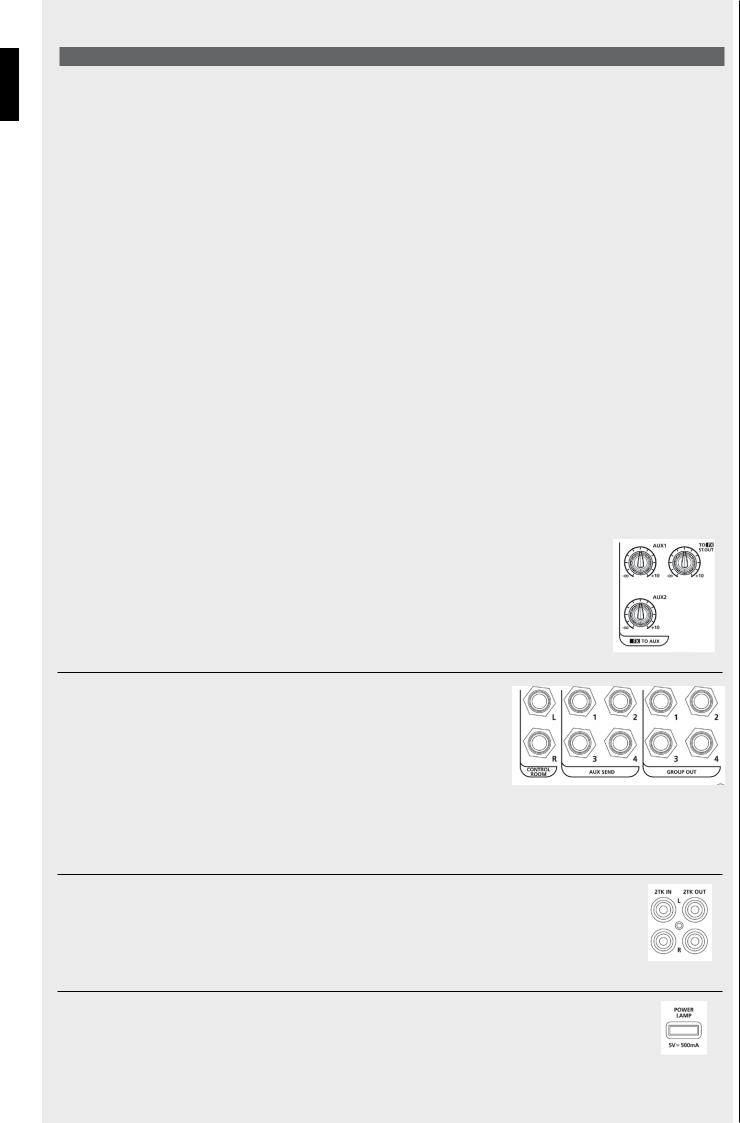
ENGLISH
FUNCTIONS
00-09 |
ECHO |
The echo is added to the sound (“delay” effect). |
|
|
Applicable to both voice and musical instruments. |
|
|
|
10-19 |
ECHO+VERB |
Echo plus reverb, similar to the previous ECHO, but more intense. |
|
|
|
20-29 |
TREMOLO |
Amplitude modulation of the sound (cyclic variation of the volume); ideal effect for electric guitar |
|
|
and organ. |
|
|
|
30-39 |
PLATE |
Plate reverb, recommended for snare drums or percussion. |
|
|
|
40-49 |
CHORUS |
Ideal reverb for adding depth and intens The “Chorus” effect adds a second signal (a copy) which is |
|
|
slightly discordant with the input, thus creating a kind of “chorus”. |
|
|
Effect recommended on guitar, keyboards and fretless bass. ity to the lead vocals or instrumental |
|
|
solos. |
|
|
|
50-59 |
VOCAL |
Ideal reverb for adding depth and intensity to the lead vocals or instrumental solos. |
|
|
|
60-69 |
ROTARY |
Simulation of a rotating speaker system, perfect effect for the organ and also suitable for electric |
|
|
pianos. |
|
|
|
70-79 |
SMALL ROOM |
Effect that reproduces the reverberation in a small room and is excellent for all instruments |
|
|
(including percussion). |
|
|
|
80-89 |
FLANGE+VERB |
The “Flanger” is an effect which is very similar to the “Chorus”, but with a stronger signal (with |
|
|
extreme settings, you can hear a kind of characteristic whistle); reverb is also added to this. |
|
|
Recommended for particular guitar and/or drums sounds. |
|
|
|
90-99 |
LARGE HALL |
This effect recreates the reverberation in a large hall; it is ideal for vocals and can also be used with |
|
|
instruments. |
|
|
|
|
|
|
[19] MANAGEMENT OF THE INTERNAL EFFECT SEND TOWARDS AUXILIARIES AND TOWARDS THE DEDICATED FX OUT
TO AUX 1: sends the output of the internal effect towards AUX 1. Ideal for sending the internal effect to a stage monitor connected to AUX 1.
TO AUX 2: sends the output of the internal effect towards AUX 2. Ideal for sending the internal effect to a stage monitor connected to AUX 2.
TO FX OUT: sends the output of the internal effect towards the dedicated FX ST. OUT output situated on the rear panel.
[20] AUDIO OUTPUTS FOR TRS 1/4“ JACK CONNECTORS.
NOTE: see also the manual section entitled „Wiring the connectors“.
PHONES: two stereo outputs (A and B) for the connection of headphones.
CONTROL ROOM: balanced L (Left channel) and R (Right channel) outputs which can be used, for instance, for connecting to amplified control room speakers (or other monitors).
AUX SEND: balanced 1, 2, 3, 4 (FX) outputs of the corresponding AUX auxiliary sends.
GROUP OUT: balanced 1, 2, 3, 4 outputs of the corresponding GROUP groups.
[21] UNBALANCED STEREO AUDIO 2TK IN INPUT AND 2TK OUT OUTPUT (RCA CONNECTORS).
2TK IN: stereo audio input (L: left channel, R: right channel) for connecting the output of an external music source (e.g. CD or MP3 player) or a recorder.
2TK OUT: stereo audio output (L: left channel, R: right channel) for connecting to the input of the recorder (or other audio device).
[22] LAMP SOCKET. USES A USB SOCKET TO POWER A LAMP WITH A 5V-500MA VOLTAGE
10
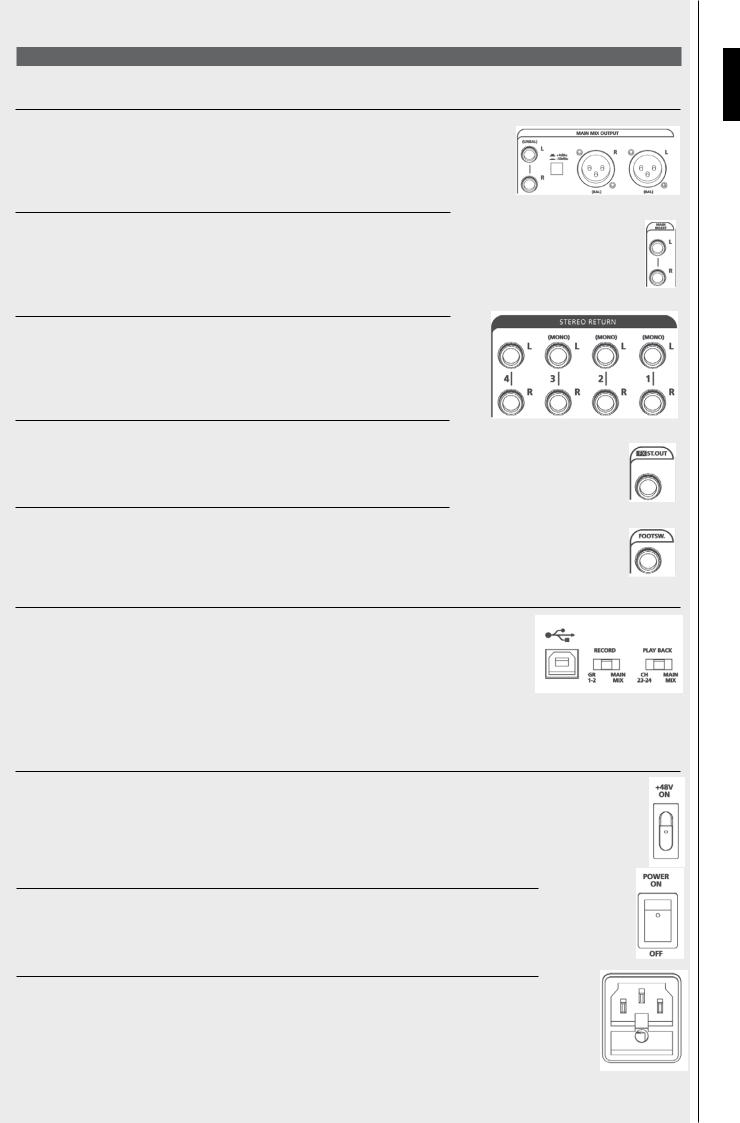
REAR PANEL
NOTE: see also the manual section entitled „Wiring the connectors.“
[24] MAIN MAIN MIX OUTPUT.
L / R (BAL) audio output: double balanced output (L: left channel, R: right channel) with XLR (m) connectors and L / R (UNBAL) audio output: double unbalanced output via 1/4“ TS jack connectors. Key: selection of the output level between +4 dBu and –30 dBu.
[25] MAIN INSERT INPUTS/OUTPUTS.
L / R: double input/output (1/4” TRS jack) for the serial connection of external signal processors (e.g. compressors); L: left channel, R: right channel.
[26] AUXILIARY STEREO RETURN RETURNS (INPUTS).
For each STEREO RETURN auxiliary return (1, 2, 3, 4), there are two balanced audio inputs (L: left channel, R: right channel) for 1/4“TRS jack connectors.
[27] FX ST.OUT OUTPUT.
The signal from the internal effects processor is present in this unbalanced stereo output (1/4“ TRS jack connector).
[28] FOOTSW. SOCKET.
Connect a pedal here, which allows the inclusion or exclusion of the internal effects. Socket (1/4“ TS jack) for a pedal (push-button, ON / OFF, normally open, e.g. certain types of SUSTAIN / DAMPER pedals for keyboards). Press once to disable the effects (FX MUTE function), press again to re-enable them.
[29] USB INTERFACE.
USB port (type B) for the connection (local) to a computer (or other audio device with a USB interface).
RECORD Set this selector to MAIN MIX to send the computer (or other audio device connected) the same audio signal present at the MAIN MIX outputs of the mixer or to GR 1-2 to send the signal of groups 1-2.
PLAYBACK Set this selector to MAIN MIX to send the audio signal from the computer (or the audio device connected) directly to the MAIN MIX outputs or to CH 15-16 (L-PAD 16CX USB) / CH 23-24 (L-PAD 24CX USB) to assign it to channels 15-16 / CH 23-24.
NOTE: if the USB audio signal is assigned to channels 15-16 / 23-24, to listen you need to set the LINE / USB selector [5] (on the front panel) to USB.
[30] „PHANTOM“ +48V POWER SWITCH.
Set the switch to the ON position to enable „Phantom“ 48V DC power in all MIC type inputs (with XLR connector) for the use of electret and/or condenser microphones (or of the „D.I. Box“) that require it. When the „Phantom“ power supply is present, you must not under any circumstances connect unbalanced cables to the MIC microphone inputs. There is a LED (+48V) on the front panel indicating whether the „Phantom“ power is enabled.
[31] MAIN POWER ON SWITCH.
Press it to turn the mixer on (ON) or off. Before you turn it on, check all the connections and set the level controls for the audio outputs to – ∞.
[32] INPUT FOR THE AC INPUT POWER SUPPLY CABLE WITH SEAT FOR THE FUSE.
Before connecting the power supply cable, make sure that all connections are correct and that the voltage of your mains supply matches the value on the device data plate; if this is not the case, please contact an RCF dealer. Connect the power supply cable only to an earthed mains outlet. When replacing the fuse, please refer to the silk-screen printed data plate.
ENGLISH
11

ENGLISH
QUICK GUIDE (example)
FOR THE FIRST USE OF THE MIXER.
•With the mixer turned off, connect active speakers (or a stereo amplifier) to the MAIN MIX [24] outputs on the rear panel.
•Make sure that all the level controls of the mixer (the „faders“) are set to – ∞.
•In sequence, turn the mixer on (using the POWER ON [31] switch), followed by the active speakers connected.
•Connect a dynamic microphone (using a balanced cable) to the XLR connector (MIC input) of channel 1. If you are using a condenser or electret microphone, you must also enable the „Phantom“ power using the +48V switch [30]).
•Press the SOLO key of the channel and make sure that the PFL / AFL key (next to the OUTPUT LEVEL LED bar) is set to PFL.
• Speak or sing into the microphone, and at the same time increase the level of the GAIN control of the channel so that the OUTPUT LEVEL LED bar indicates a value of about 0 dB.
•Release the SOLO key of the channel.
•Make sure that the MUTE key of the channel is released and press the L-R key.
•Raise the level control (the „fader“) of the channel up to a value of 0 dB.
•Carefully raise the level control (the „fader“) of the MAIN MIX main outputs [14] until you reach the desired volume of the speakers.
WIRING THE CONNECTORS
1/4” JACK CONNECTOR
|
|
BALANCED (TRS) |
|
UNBALANCED (TS) |
|
|
Tip = Hot |
|
|
Tip = Hot |
|
|
|
Ring = Cold |
|
|
|
|
|
|
|
Sleeve = Ground |
|
|
|
Sleeve = Ground |
|
|
|
|
|
|
|
|
|
Tip |
Ring |
Sleeve |
Tip |
|
Sleeve |
|
|
|
|
|
|
|
|
|
|
|
|
|
|
|
|
|
|
|
|
INSERT (TRS) |
|
|
PHONES (TRS) |
|
Tip = Signal Send |
|
Tip=Left Channel |
||
|
|
Ring = Signal Return |
|
|
Ring = Right Channel |
|
|
Sleeve = Ground |
|
|
Sleeve = Ground |
Tip |
Ring |
Sleeve |
Tip |
Ring |
Sleeve |
|
|
|
|
||
|
|
|
|
|
|
XLR CONNECTOR
XLR connector pinout: |
|
|
|
1 |
= earth |
|
|
2 |
= audio signal (+ or „hot“) |
|
|
3 |
= audio signal (– or „cold“) |
XLR Connector (F) |
XLR Connector (M) |
12
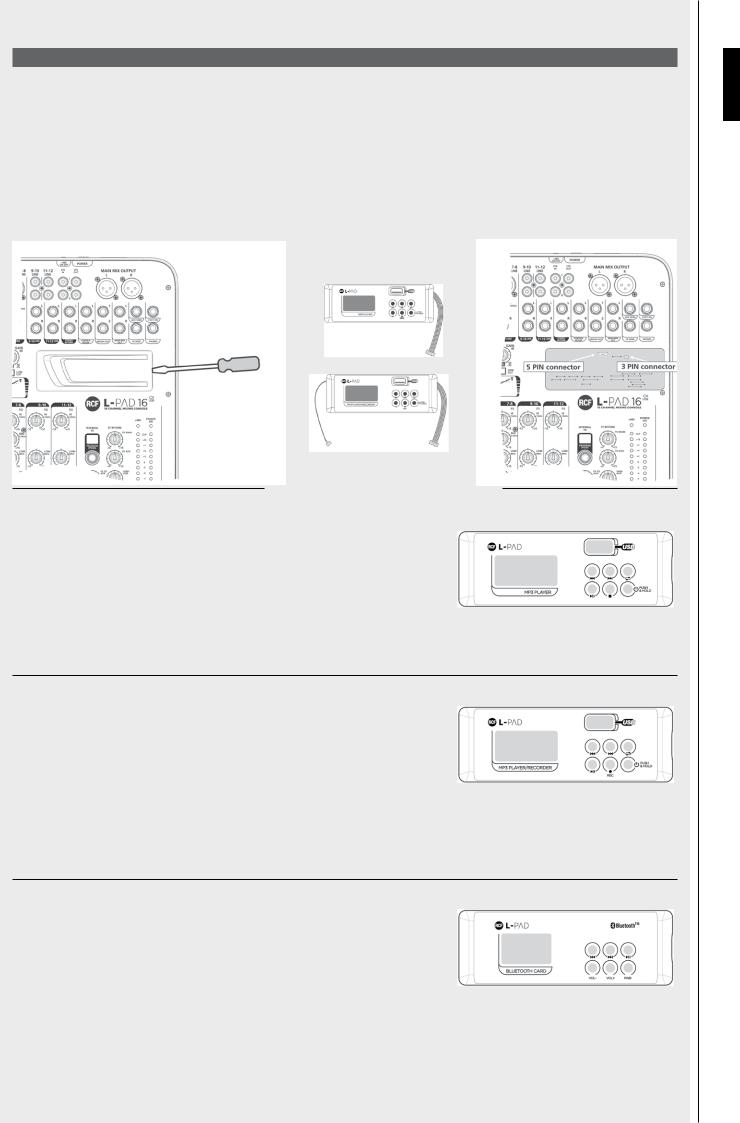
OPTIONAL CARDS
INSTALLATION
With the help of a small flat-tip screwdriver, press horizontally on the right side of the plastic cover and remove it carefully.
To install an L-PAD BLUETOOTH card or a L-PAD PLAYER USB MP3 card, connect the cable with 5-pin connector to the corresponding connector (5-pin) on the printed circuit board, as shown here.
To install an L-PAD PLAYER/RECORDER USB MP3, connect the cable with 5-pin connector to the corresponding connector (5-pin) on the printed circuit board and the cable with 3-pin connector to the corresponding connector (3-pin), as shown here.
Now, fit the optional card into the purpose-designed seat and take advantage of the new functions.
Gently remove the plastic cover |
Be sure to connect |
with the help of a screwdriver. |
each connector in its proper position. |
3 pin connector |
5 pin connector |
|
|
MP3 PLAYER CARD
Using a computer, copy all the MP3 audio files you want into a USB flash drive, even organised into folders (up to a maximum of 32 GB). Insert a USB flash drive into the purpose-designed connector on the card and hold the PUSH & HOLD button for two seconds: the first file in the first folder will start playing; the display alternates between showing the file number and folder number currently playing. Press the ▐◄◄ button to skip to the previous track or ►►▌ to the next; hold down the same buttons to change folder. Use the ►▌▌ (PLAY/PAUSE) button to pause or resume playback, press ■ (STOP) to
stop playing. Press the  (loop) button repeatedly to select the random play, to play the current track repeatedly in sequence or to play the entire playlist repeatedly in sequence respectively. Turn the 2TK LEVEL control clockwise, taking it to the central position („12 o‘clock“) and verify that the 2TK TO MAIN MIX key is pressed. Carefully raise the MAIN MIX control (fader) until you reach the desired listening level.
(loop) button repeatedly to select the random play, to play the current track repeatedly in sequence or to play the entire playlist repeatedly in sequence respectively. Turn the 2TK LEVEL control clockwise, taking it to the central position („12 o‘clock“) and verify that the 2TK TO MAIN MIX key is pressed. Carefully raise the MAIN MIX control (fader) until you reach the desired listening level.
MP3 PLAYER/RECORDER CARD
Using a computer, copy all the MP3 audio files you want into a USB flash drive, even organised into folders (up to a maximum of 32 GB). Insert a USB flash drive into the purpose-designed connector on the card and hold the PUSH & HOLD button for two seconds: the first file in the first folder will start playing; the display alternates between showing the file number and folder number currently playing. You can record the audio signal present at the MAIN MIX output. Press the REC button once: the player is now in „rec ready“ („ready to record“) mode and the display shows a flashing
REC; press REC again to start recording. Press the PUSH & HOLD button once to stop recording; the card creates a new folder on the USB drive, called „FrE01“, where the files created will be stored. Use the ►▌▌ (PLAY/PAUSE) button to pause or resume recording. Press the  (loop) button repeatedly to select the random play, to play the current track repeatedly in sequence or to play the entire playlist repeatedly in sequence respectively. Turn the 2TK LEVEL control clockwise, taking it to the central position („12 o‘clock“) and verify that the 2TK TO MAIN MIX key is pressed. Carefully raise the MAIN MIX control (fader) until you reach the desired listening level.
(loop) button repeatedly to select the random play, to play the current track repeatedly in sequence or to play the entire playlist repeatedly in sequence respectively. Turn the 2TK LEVEL control clockwise, taking it to the central position („12 o‘clock“) and verify that the 2TK TO MAIN MIX key is pressed. Carefully raise the MAIN MIX control (fader) until you reach the desired listening level.
BLUETOOTH CARD
Enable the Bluetooth interface on the mobile device and press the PAIR button on the card.
The mobile device should recognise the Bluetooth device as „BT2.1“; next, make the association between the two devices. Now you can play your favourite tracks: on the mixer, turn the 2TK LEVEL control clockwise, taking it to the central position („12 o‘clock“) and verify that the 2TK TO MAIN MIX key is pressed. Carefully raise the MAIN MIX control (fader) until you reach the desired listening level; to adjust the volume on the panel of the card, you can also press the VOL+ and VOLbuttons.
ENGLISH
13
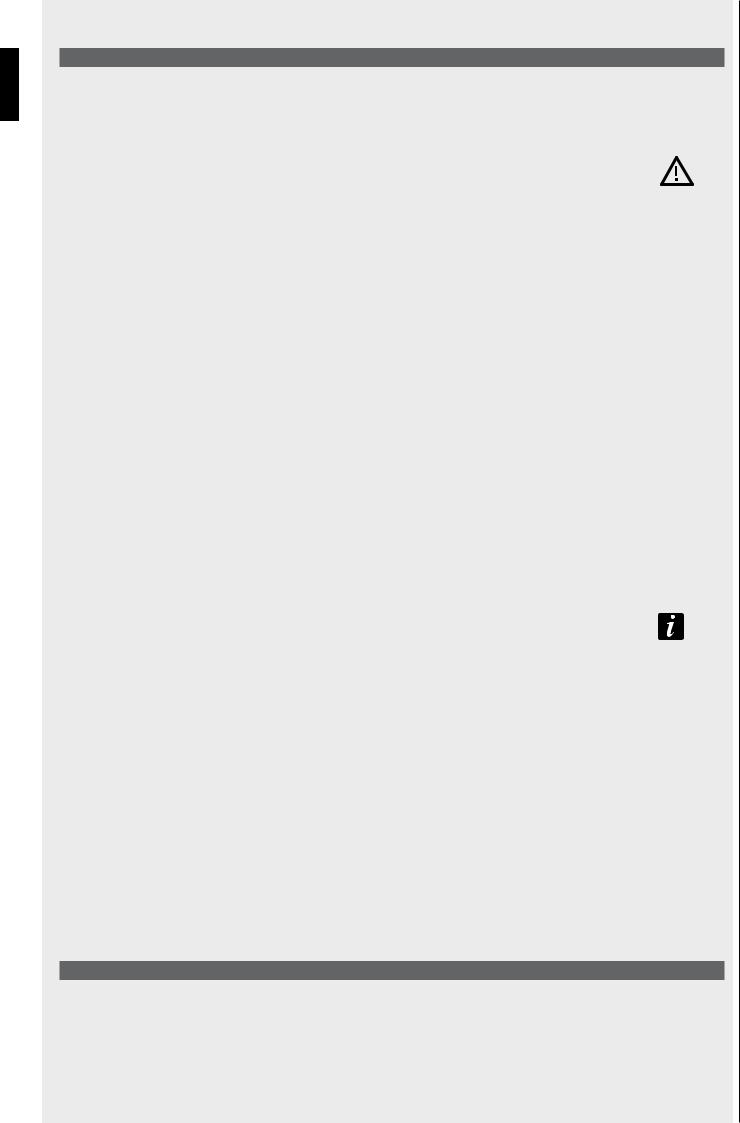
ITALIANO
AVVERTENZE PER LA SICUREZZA
Prima di collegare ed utilizzare questo prodotto, leggere attentamente le istruzioni contenute in questo manuale, il quale è da conservare per riferimenti futuri.
Il presente manuale costituisce parte integrante del prodotto e deve accompagnare quest’ultimo anche nei passaggi di proprietà, per permettere al nuovo proprietario di conoscere le modalità d’installazione e d’utilizzo e le avvertenze per la sicurezza. L’installazione e l’utilizzo errati del prodotto esimono la RCF S.p.A. da ogni responsabilità.
ATTENZIONE: per prevenire i rischi di fiamme o scosse elettriche, non esporre mai questo prodotto alla pioggia o all’umidità.
1. Tutte le avvertenze, in particolare quelle relative alla sicurezza, devono essere lette con particolare attenzione, in quanto |
WARNINGS |
contengono importanti informazioni. |
|
2. ALIMENTAZIONE PRINCIPALE DA RETE ELETTRICA
a.La tensione di alimentazione dell’apparecchio ha un valore sufficientemente alto da costituire un rischio di folgorazione per le persone: non procedere mai all’installazione od alla connessione dell’apparecchio con il cavo dell’alimentazione collegato alla rete elettrica.
b.Prima di alimentare questo prodotto, assicurarsi che tutte le connessioni siano corrette e che la tensione della vostra rete di alimentazione corrisponda quella di targa dell’apparecchio, in caso contrario rivolgetevi ad un rivenditore RCF.
c.Le parti metalliche dell’apparecchio sono collegate a terra tramite il cavo di alimentazione. Un apparecchio avente costruzione di CLASSE I deve essere connesso alla presa di rete con un collegamento alla terra di protezione.
d.Accertarsi che il cavo di alimentazione dell’apparecchio non possa essere calpestato o schiacciato da oggetti, al fine di salvaguardarne la perfetta integrità.
e.Per evitare il rischio di shock elettrici, non aprire mai l’apparecchio: all’interno non vi sono parti che possono essere utilizzate dall’utente.
3.Impedire che oggetti o liquidi entrino all’interno del prodotto, perché potrebbero causare un corto circuito. L’apparecchio non deve essere esposto a stillicidio o a spruzzi d’acqua; nessuna sorgente di fiamma nuda (es. candele accese) e nessun oggetto pieno di liquido (es. vasi) deve essere posto sull’apparecchio.
4.Non eseguire sul prodotto interventi / modifiche / riparazioni se non quelle espressamente descritte sul manuale istruzioni. Contattare centri di assistenza autorizzati o personale altamente qualificato quando:
- l’apparecchio non funziona (o funziona in modo anomalo); - il cavo di alimentazione ha subito gravi danni;
- oggetti o liquidi sono entrati nell’apparecchio; - l’apparecchio ha subito forti urti.
5.Qualora questo prodotto non sia utilizzato per lunghi periodi, scollegare il cavo d‘alimentazione dalla rete.
6.Nel caso che dal prodotto provengano odori anomali o fumo, spegnerlo immediatamente e scollegare il cavo d‘alimentazione.
7.Non collegare a questo prodotto altri apparecchi e accessori non previsti. Non cercare di appendere questo prodotto tramite elementi non idonei o previsti allo scopo. Per evitare il pericolo di cadute, non sovrapporre fra loro più unità di questo prodotto, quando questa possibilità non è espressamente contemplata dal manuale istruzioni.
8.La RCF S.p.A. raccomanda vivamente che l’installazione di questo prodotto sia eseguita solamente da installatori professionali qualificati (oppure da ditte specializzate) in grado di farla correttamente e certificarla in accordo con le normative vigenti. Tutto il sistema audio dovrà essere in conformità con le norme e le leggi vigenti in materia di impianti elettrici.
9.Sostegni e Carrelli
Se previsto, il prodotto va utilizzato solo su carrelli o sostegni consigliati dal produttore. L’insieme apparecchio-sostegno / carrello va mosso con estrema cura. Arresti improvvisi, spinte eccessive e superfici irregolari o inclinate possono provocare il ribaltamento dell’assieme.
10. Perdita dell’udito
L’esposizione ad elevati livelli sonori può provocare la perdita permanente dell’udito. Il livello di pressione acustica pericolosa per l’udito varia sensibilmente da persona a persona e dipende dalla durata dell’esposizione. Per evitare un’esposizione potenzialmente pericolosa ad elevati livelli di pressione acustica, è necessario che chiunque sia sottoposto a tali livelli utilizzi delle adeguate protezioni; quando si fa funzionare un trasduttore in grado di produrre elevati livelli sonori è necessario indossare dei tappi per orecchie o delle cuffie protettive. Consultare i dati tecnici istruzioni per conoscere le massime pressioni sonore che i diffusori acustici sono in grado di produrre.
11.Collocare il prodotto lontano da fonti di calore e garantire la circolazione dell’aria intorno.
12.Non sovraccaricare questo prodotto per lunghi periodi.
13.Non forzare mai gli organi di comando (tasti, manopole ecc.).
14.Non usare solventi, alcool, benzina o altre sostanze volatili per la pulitura delle parti esterne dell‘unità; usare un panno asciutto.
15.Non puntare microfoni vicino ed in fronte ai diffusori acustici, in modo da evitare qualsiasi retroazione (“effetto Larsen”).
NOTA SUI CAVI PER SEGNALI AUDIO
Per evitare fenomeni di rumorosità indotta sui cavi che trasportano segnali dai microfoni o di linea (per esempio 0dB), usare solo cavi schermati ed evitare di posarli nelle vicinanze di:
- apparecchiature che producono campi elettromagnetici di forte intensità; - cavi della rete elettrica;
- linee altoparlanti.
14 |
RCF S.p.A. Vi ringrazia per l‘acquisto di questo prodotto, realizzato in modo da garantirne l‘affidabilità e prestazioni elevate. |
|
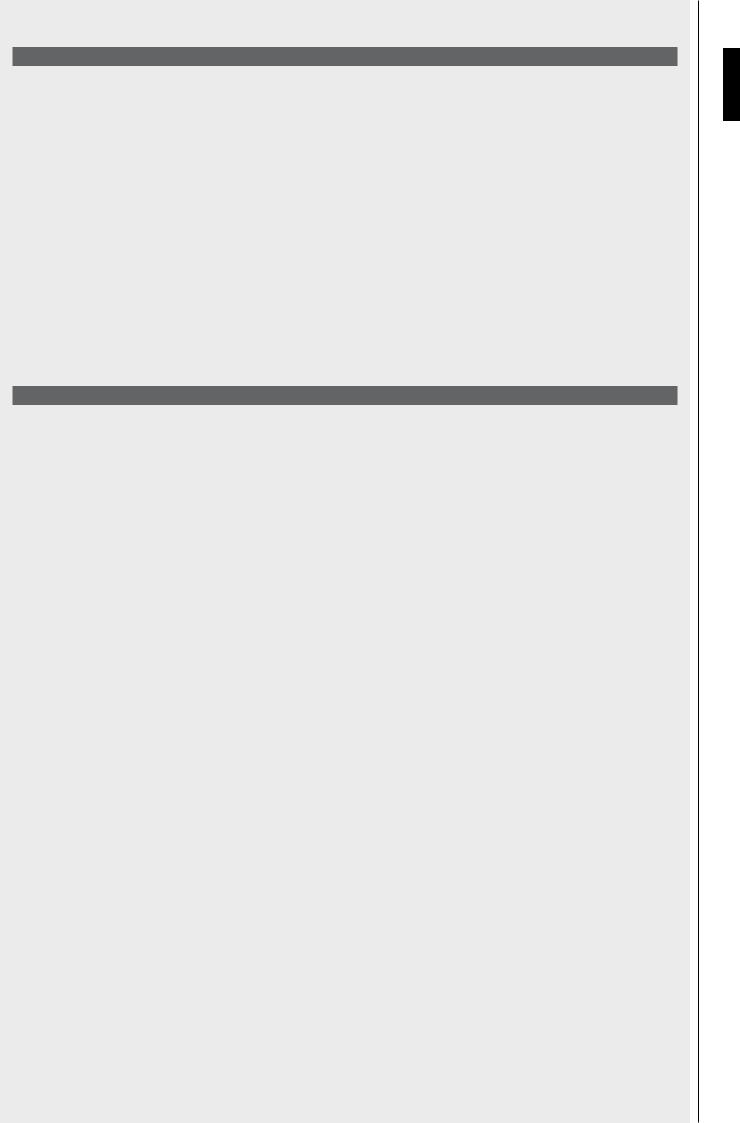
INFORMAZIONI SUL DISPOSITIVO
Grazie per aver acquistato un mixer RCF mixing consoles.
L-PAD16CXusb e L-PAD24CXusb sono mixer audio versatili dotati di tutti gli strumenti necessari per una corretta elaborazione di segnali audio multipli provenienti da diverse sorgenti. Le funzionalità sono espandibili mediante l‘aggiunta di schede opzionali che consentono di implementare funzioni di riproduzione/registrazione audio MP3 o Bluetooth.
SUONO LIMPIDO
I dispositivi RCF mixing consoles combinano la „sound culture“ professionale di RCF con l‘innovazione del design e la fabbricazione dedicata. Le console di mixaggio RCF mixing consoles garantiscono un suono limpido, dinamiche del suono accurate e un‘estrema versatilità d‘uso per utenti professionali appassionati. I mixer RCF mixing consoles sono progettati per integrarsi in maniera ottimale con gli altoparlanti attivi RCF.
AFFIDABILITÀ
Durante la fabbricazione, tutti i mixer RCF mixing consoles sono sottoposti a quattro approfonditi test strumentali di qualità. Al termine della produzione viene eseguito un test di ascolto, seguito da un controllo finale della qualità volto a individuare eventuali difetti visibili quali graffi o ammaccature. Questo processo garantisce una straordinaria affidabilità e la massima qualità del dispositivo che avete appena acquistato.
DESIGN
L‘esclusivo design dei mixer RCF mixing consoles e espressione della creatività RCF tipicamente italiana. I mixer RCF mixing consoles sono caratterizzati da un moderno design ergonomico di eccellente livello. Oltre ad essere esteticamente gradevoli, gli originali profili laterali dei mixer li rendono facili da impugnare in tutta sicurezza.
DESCRIZIONE E CARATTERISTICHE PRINCIPALI
L-PAD 24CX USB e L-PAD 16CX USB sono mixer audio analogici versatili, dotati di porta seriale USB per il collegamento ad un computer e di tutti gli strumenti necessari per una corretta elaborazione di segnali audio multipli provenienti da diverse sorgenti. I due modelli differiscono solo dal numero di canali disponibili; entrambi sono espandibili mediante l‘aggiunta di schede opzionali che consentono di implementare funzioni di riproduzione e registrazione audio di file MP3 o BLUETOOTH. È presente un processore digitale interno per gli effetti che permette la scelta tra 99 preset.
INGRESSI AUDIO L-PAD 24CX USB
-- CANALI 1÷16: ingressi microfonici MIC (connettore XLR) oppure per segnali a livello “linea” LINE (jack da ¼”), equalizzazione a tre bande con medi semi-parametrici, collegamento seriale per processori esterni INSERT (jack da ¼”); compressore di segnale sui primi 8 ingressi.
-- CANALI 17-18 e 19-20: ingressi microfonici MIC (connettore XLR) oppure per segnali stereo a livello “linea” LINE (doppio jack da ¼”) con equalizzazione a quattro bande.
-- CANALI 21-22 e 23-24: ingressi per segnali stereo a livello “linea” LINE (doppio jack da ¼”) con equalizzazione a quattro bande; i canali 23-24 sono alternativamente assegnabili alla porta seriale USB.
INGRESSI AUDIO L-PAD 16CX USB
-- CANALI 1÷8: ingressi microfonici MIC (connettore XLR) oppure per segnali a livello “linea” LINE (jack da ¼”), equalizzazione a tre bande con medi semi-parametrici, collegamento seriale per processori esterni INSERT (jack da ¼”); compressore di segnale sui primi 6 ingressi.
-- CANALI 9-10 e 11-12: ingressi microfonici MIC (connettore XLR) oppure per segnali stereo a livello “linea” LINE (doppio jack da ¼”) con equalizzazione a quattro bande.
-- CANALI 13-14 e 15-16: ingressi per segnali stereo a livello “linea” LINE (doppio jack da ¼”) con equalizzazione a quattro bande; i canali 15-16 sono alternativamente assegnabili alla porta seriale USB.
INGRESSI ED USCITE COMUNI AD ENTRAMBI I MODELLI
-- Uscita stereo principale MAIN MIX con connettori XLR (bilanciati) e jack da ¼” (sbilanciati). -- Collegamento MAIN INSERT sulle uscite principali per processori esterni (jack da ¼”).
-- Uscita stereo CONTROL ROOM (doppio jack da ¼”). -- 4 uscite gruppi GROUP OUT (jack da ¼”).
-- 4 mandate ausiliarie AUX SEND (jack da ¼”).
-- 4 ritorni stereo STEREO RETURN (doppi jack da ¼”).
-- Ingresso audio 2TK IN (doppio connettore RCA) per sorgente musicale (es. lettore CD, MP3, ecc.) o registratore. -- Uscita audio 2TK OUT per registratore.
-- Uscita effetti FX STEREO OUT con connettore jack stereo da ¼”.
-- 1 presa jack FOOTSW. (jack ¼” TS) per controllo a pedale per l’attivazione o disattivazione degli effetti. -- Porta USB per collegamento audio da e per computer.
-- 2 uscite per cuffie PHONES (jack stereo da ¼”).
Slot per schede opzionali:
-- L-PAD PLAYER: lettore MP3 su unità USB, max. capacità 32 GB, cod. 13360287;
-- L-PAD PLAYER / RECORDER: lettore / registratore MP3 su unità USB, max. capacità 32 GB, cod. 13360288;
-- L-PAD BLUETOOTH: scheda di connessione “Bluetooth” che consente di riprodurre le proprie playlist musicali da “smartphone”, “tablet” o qualsiasi dispositivo con interfaccia “Bluetooth”, cod.: 13360289.
ITALIANO
15
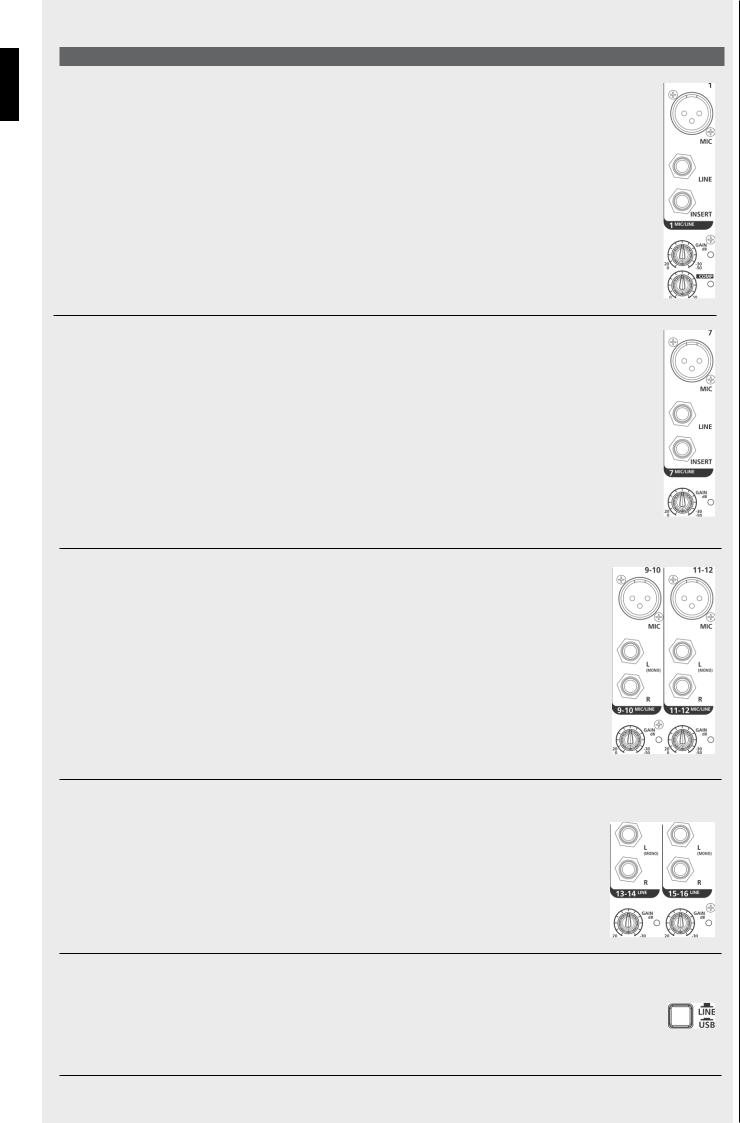
ITALIANO
FUNZIONI
[1] INGRESSI DEI CANALI DA 1 A 6 (L-PAD 16CX USB) / DA 1 A 8 (L-PAD 24CX USB).
NOTA: vedere anche la sezione del manuale “Cablaggio dei connettori”.
MIC: ingresso bilanciato con connettore XLR (f) per microfono, dotato di alimentazione “Phantom” (disinseribile) per l‘utilizzo di microfoni a condensatore od elettrete.
LINE: ingresso bilanciato a “livello linea” per connettore jack 1/4” TRS (o sbilanciato, jack 1/4” TS).
INSERT: ingresso / uscita (jack 1/4” TRS) per il collegamento seriale di un processore esterno di segnale (es. compressore).
GAIN: controllo del guadagno (MIC: 0 ÷ –50 dB; LINE: +20 ÷ –30 dB).
COMP: controllo del compressore che agisce sia sulla soglia d‘intervento sia sul rapporto di compressione (0: nessuna compressione).
[2] INGRESSI DEI CANALI 7 E 8 (L-PAD 16CX USB) / DA 9 A 16 (L-PAD 24CX USB).
NOTA: vedere anche la sezione del manuale “Cablaggio dei connettori”.
MIC: ingresso bilanciato con connettore XLR (f) per microfono, dotato di alimentazione “Phantom” (disinseribile) per l‘utilizzo di microfoni a condensatore od elettrete.
LINE: ingresso bilanciato a “livello linea” per connettore jack 1/4” TRS (o sbilanciato, jack 1/4” TS).
INSERT: ingresso / uscita (jack 1/4 TRS) per il collegamento seriale di un processore esterno di segnale (es. compressore).
GAIN: controllo del guadagno (MIC: 0 ÷ –50 dB; LINE: +20 ÷ –30 dB).
[3] INGRESSI DEI CANALI 9-10 E 11-12 (L-PAD 16CX USB) / 17-18 E 19-20 (L-PAD 24CX USB).
NOTA: vedere anche la sezione del manuale “Cablaggio dei connettori”.
MIC: ingresso bilanciato con connettore XLR (f) per microfono, dotato di alimentazione “Phantom” (disinseribile) per l‘utilizzo di microfoni a condensatore od elettrete.
L (mono) / R: ingresso bilanciato stereo a “livello linea” (doppio jack 1/4” TRS).
L (left): canale sinistro; R (right): canale destro.
Usare solo l‘ingresso L per segnali “mono”.
GAIN: controllo del guadagno (MIC: 0 ÷ –50 dB; L / R: +20 ÷ –30 dB).
[4] INGRESSI DEI CANALI 13-14 E 15-16 (L-PAD 16CX USB) / 21-22 E 23-24 (L-PAD 24CX USB).
NOTA: vedere anche la sezione del manuale “Cablaggio dei connettori”.
L (mono) / R: ingresso bilanciato stereo a “livello linea” (doppio jack 1/4” TRS).
L (left): canale sinistro; R (right): canale destro.
Usare solo l‘ingresso L per segnali “mono”.
GAIN: controllo del guadagno (+20 ÷ –30 dB).
[5] SELETTORE LINE / USB DEI CANALI 15-16 (L-PAD 16CX USB) / 23-24 (L-PAD 24CX USB).
LINE: i canali 15-16 (L-PAD 16CX USB) / 23-24 (L-PAD 24CX USB) sono normalmente assegnati ai rispettivi ingressi jack 1/4”.
USB: i canali 15-16 (L-PAD 16CX USB) / 23-24 (L-PAD 24CX USB) sono assegnati all‘interfaccia USB (per ricevere il segnale audio dal computer collegato).
16
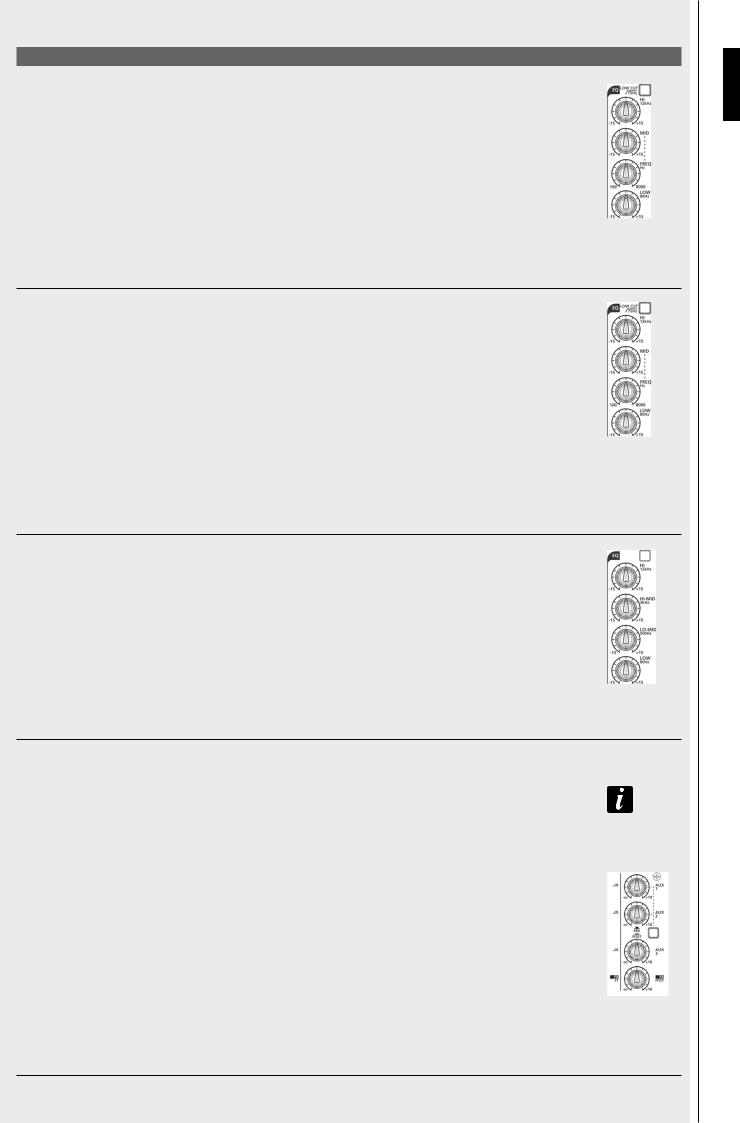
FUNZIONI
[6] EQUALIZZAZIONE CANALI DA 1 A 8 (L-PAD 16CX USB) / DA 1 A 16 (L-PAD 24CX USB).
LOW CUT: se premuto, inserisce un filtro passa-alto nel rispettivo canale con frequenza di taglio 75 Hz e pendenza 12 dB / ottava.
È consigliabile inserirlo solo quando si utilizzano microfoni per la voce (o per strumenti con estensione limitata sulle basse frequenze), in modo da prevenire eventuali rimbombi.
HI: controllo del livello delle frequenze alte (12 kHz, –15 ÷ +15 dB).
MID: controllo semi-parametrico del livello delle frequenze medie (–15 ÷ +15 dB), la cui frequenza di intervento è selezionabile (100 ÷ 8000 Hz) tramite il controllo FREQ.
LOW: controllo del livello delle frequenze basse (80 Hz, –15 ÷ +15 dB).
[7] EQUALIZZAZIONE CANALI 9-10 E 11-12 (L-PAD 16CX USB) / 17-18 E 19-20 (L-PAD 24CX USB).
LOW CUT: se premuto, inserisce un filtro passa-alto nel rispettivo canale con frequenza di taglio 75 Hz e pendenza 12 dB / ottava.
È consigliabile inserirlo solo quando si utilizzano microfoni per la voce (o per strumenti con estensione limitata sulle basse frequenze), in modo da prevenire eventuali rimbombi.
HI: controllo del livello delle frequenze alte (12 kHz, –15 ÷ +15 dB).
HI-MID: controllo del livello delle frequenze medio-alte (3 kHz, –15 ÷ +15 dB).
LO-MID: controllo del livello delle frequenze medio-basse (500 Hz, –15 ÷ +15 dB).
LOW: controllo del livello delle frequenze basse (80 Hz, –15 ÷ +15 dB).
[8] EQUALIZZAZIONE CANALI 13-14 E 15-16 (L-PAD 16CX USB) / 21-22 E 23-24 (L-PAD 24CX USB).
HI: controllo del livello delle frequenze alte (12 kHz, –15 ÷ +15 dB).
HI-MID: controllo del livello delle frequenze medio-alte (3 kHz, –15 ÷ +15 dB).
LO-MID: controllo del livello delle frequenze medio-basse (500 Hz, –15 ÷ +15 dB).
LOW: controllo del livello delle frequenze basse (80 Hz, –15 ÷ +15 dB).
[9] CONTROLLI DEI LIVELLI DELLE MANDATE AUSILIARIE AUX ED EFFETTO FX PER CIASCUN CANALE.
NOTA IMPORTANTE
Vi sono due tipi di controlli dei livelli delle mandate ausiliarie:
PRE-FADER (indipendente dal controllo del livello del canale), da utilizzarsi per i monitor da palco;
POST-FADER (successivo e quindi soggetto al controllo del livello del canale), utilizzabili per il collegamento, per esempio, IMPORTANTE di processori di segnale (effetti come riverbero, delay, ecc.).
Le mandate AUX 1 e 2 sono selezionabili PRE / POST-FADER, AUX 3 e FX sono solo POST-FADER.
Il controllo dell‘effetto può essere usato come quarta mandata ausiliaria (disattivando l‘effetto interno tramite il tasto FXMUTE) per il collegamento ad un processore di segnale esterno.
AUX 1: controllo del livello della mandata ausiliaria AUX 1 (– ∞ ÷ +10 dB).
AUX 2: controllo del livello della mandata ausiliaria AUX 2 (– ∞ ÷ +10 dB).
PRE / POST: AUX 1 e 2 sono PRE-FADER se questo tasto è rilasciato oppure POST-FADER se premuto.
AUX 3: controllo del livello della mandata ausiliaria AUX 3 (– ∞ ÷ +10 dB).
FX: controllo del livello dell‘effetto o quarta mandata ausiliaria (– ∞ ÷ +10 dB).
17
ITALIANO
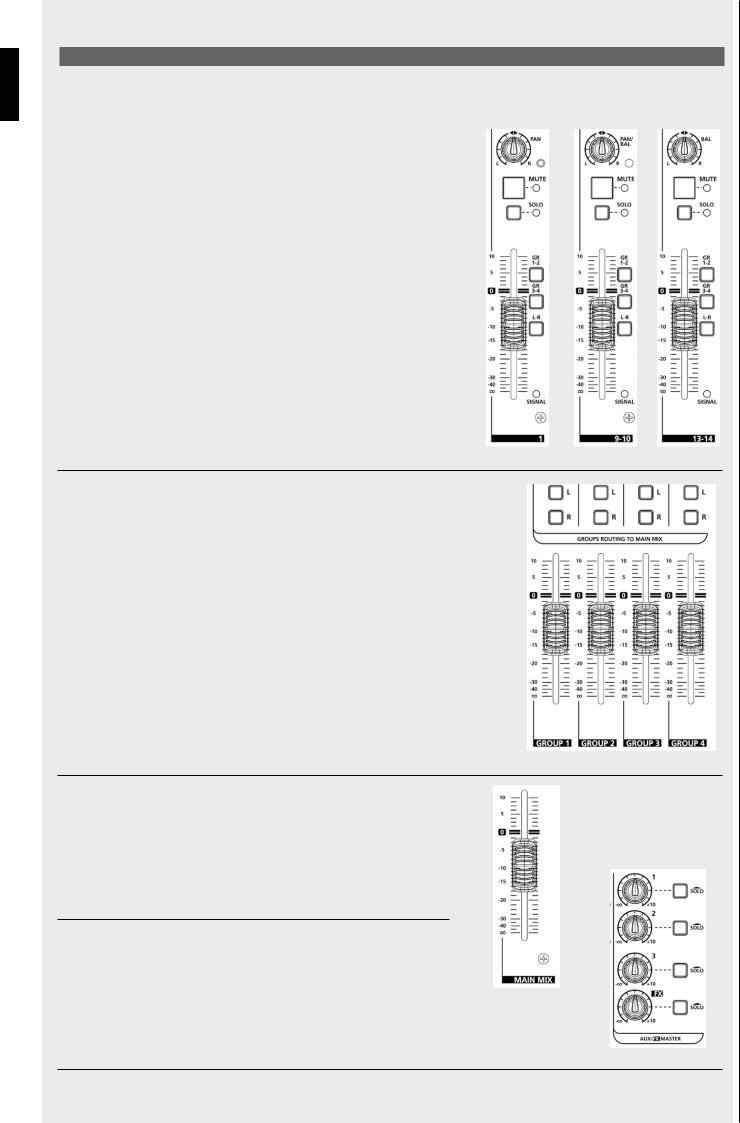
ITALIANO
FUNZIONI
[10 - 11 - 12] CONTROLLI DI LIVELLO ED ASSEGNAZIONE DEI CANALI.
PAN o PAN/BAL o BAL: controllo per definire la posizione del rispettivo segnale d‘ingresso nell‘immagine stereo (L: canale sinistro, R: canale destro) oppure il bilanciamento di un segnale stereo.
Se i gruppi GR 1-2 e/o GR 3-4 sono attivati, lo stesso controllo indirizza il segnale ai gruppi 1 e 3 (se ruotato a sinistra) oppure 2 e 4 (se ruotato a destra) o tutti (MONO) (se posto al centro).
MUTE: premere questo tasto (LED rosso acceso) spegne il canale relativo interrompendo il segnale verso il MAIN MIX e verso i GROUP OUT.
SOLO: se premuto (LED rosso acceso), il rispettivo canale è in modalità SOLO ed il suo segnale è inviato alle uscite CONTROL ROOM e PHONES A-B.
FADER (potenziometro da 60 mm): regolazione del livello (volume) del rispettivo canale (– ∞ ÷ +10 dB).
GR 1-2: se premuto, il rispettivo canale è assegnato al gruppo 1-2.
GR 3-4: se premuto, il rispettivo canale è assegnato al gruppo 3-4.
L-R: se premuto, il segnale del rispettivo canale è direttamente inviato all‘uscita MAIN MIX.
SIGNAL: LED verde, indica la presenza del segnale al rispettivo ingresso.
[13] CONTROLLI DI LIVELLO ED ASSEGNAZIONE DEI GRUPPI.
L: se premuto, il segnale audio del rispettivo gruppo è inviato al canale sinistro (“left”) dell‘uscita MAIN MIX.
R: se premuto, il segnale audio del rispettivo gruppo è inviato al canale destro (“right”) dell‘uscita MAIN MIX.
FADER (potenziometro da 60 mm): controllo del livello (volume) del rispettivo gruppo (– ∞ ÷ +10 dB).
[14] CONTROLLO DI LIVELLO DELLE USCITE AUDIO MAIN MIX.
FADER (potenziometro di 60 mm): controllo del livello (volume) delle uscite audio MAIN MIX (– ∞ ÷ +10 dB).
[15] CONTROLLI GENERALI DEI LIVELLI DELLE MANDATE AUSILIARIE AUX ED EFFETTO FX.
1 / 2 / 3 / FX: controlli dei livelli generali delle rispettive mandate ausiliare e della mandata all’effetto interno (– ∞ ÷ +10 dB).
SOLO: se premuto, la rispettiva mandata ausiliaria è in modalità SOLO ed il suo segnale è inviato alle uscite CONTROL ROOM e PHONES A-B.
18
